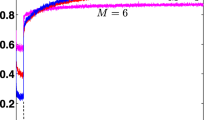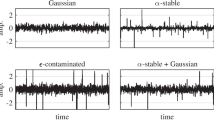Abstract
Many statistical signal processing problems found in wireless communications involves making inference about the transmitted information data based on the received signals in the presence of various unknown channel distortions. The optimal solutions to these problems are often too computationally complex to implement by conventional signal processing methods. The recently emerged Bayesian Monte Carlo signal processing methods, the relatively simple yet extremely powerful numerical techniques for Bayesian computation, offer a novel paradigm for tackling wireless signal processing problems. These methods fall into two categories, namely, Markov chain Monte Carlo (MCMC) methods for batch signal processing and sequential Monte Carlo (SMC) methods for adaptive signal processing. We provide an overview of the theories underlying both the MCMC and the SMC. Two signal processing examples in wireless communications, the blind turbo multiuser detection in CDMA systems and the adaptive detection in fading channels, are provided to illustrate the applications of MCMC and SMC respectively.
Similar content being viewed by others
References
J.G. Proakis, Digital Communications, 3rd edn., New York: McGraw-Hill, 1995.
S. Verdú, Multiuser Detection, Cambridge, UK: Cambridge University Press, 1998.
R. Haeb and H. Meyr, “A Systematic Approach to Carrier Recovery and Detection of Digitally Phase Modulated Signals on Fading Channels,” IEEE Trans. Commun., vol. 37,no. 7, 1989, pp. 748-754.
J.S. Liu, Monte Carlo Methods in Scientific Computing, New York: Springer-Verlag, 2001.
N. Metropolis, A.W. Rosenbluth, A.H. Teller, and E. Teller, “Equations of State Calculations by Fast Computing Machines,” J. Chemical Physics, vol. 21, 1953, pp. 1087-1091.
W.K. Hastings, “Monte Carlo Sampling Methods Using Markov Chains and Their Applications,” Biometrika, vol. 57, 1970, pp. 97-109.
S. Geman and D. Geman, “Stochastic Relaxation, Gibbs Distribution, and the Bayesian Restoration of Images,” IEEE Trans. Pattern Anal. Machine Intell., vol. PAMI-6,no. 11, 1984, pp. 721-741.
M.A. Tanner and W.H. Wong, “The Calculation of Posterior Distribution by Data Augmentation (with Discussion),” J. Amer. Statist. Assoc., vol. 82, 1987, pp. 528-550.
A.E. Gelfand and A.F.W. Smith, “Sampling-Based Approaches to Calculating Marginal Densities,” J. Amer. Stat. Assoc., vol. 85, 1990, pp. 398-409.
J.S. Liu, “The Collapsed Gibbs Sampler with Applications to a Gene Regulation Problem,” J. Amer. Statist. Assoc, vol. 89, 1994, pp. 958-966.
C.J. Geyer, “Markov Chain Monte Carlo Maximum Likelihood,” in Computing Science and Statistics: Proceedings of the 23rd Symposium on the Interface, E.M. Keramigas (Ed.), Fairfax: Interface Foundation, 1991, pp. 156-163.
J.S. Liu, F. Ling, and W.H. Wong, “The Use of Multiple-Try Method and Local Optimization in Metropolis sampling,” J. Amer. Statist. Assoc, vol. 95, 2000, pp. 121-134.
F. Liang and W.H. Wong, “Evolutionary Monte Carlo: Applications to c p Model Sampling and Change Point Problem,” Statistica Sinica, vol. 10, 2000, pp. 317-342.
X. Wang and R. Chen, “Adaptive Bayesian Multiuser Detection for Synchronous CDMA in Gaussian and Impulsive Noise,” IEEE Trans. Sign. Proc, vol. 48,no. 7, 2000, pp. 2013-2028.
J. Hagenauer, “The Turbo Principle: Tutorial Introduction and State of the Art,” in Proc. International Symposium on Turbo Codes and Related Topics, Brest, France, Sept. 1997, pp. 1-11.
L.R. Bahl, J. Cocke, F. Jelinek, and J. Raviv, “Optimal Decoding of Linear Codes for Minimizing Symbol Error Rate,” IEEE Trans. Inform. Theory, vol. IT-20,no. 3, 1974, pp. 284-287.
G.E. Box and G.C. Tiao, Bayesian Inference in Statistical Analysis, Reading, MA: Addison-Wesley, 1973.
A. Gelman, J.B. Carlin, H.S. Stern, and D.B. Rubin, Bayesian Data Analysis, Chapman & Hall, 1995.
E.L. Lehmann and G. Casella, Theory of Point Estimation, 2nd edn., New York: Springer-Verlag, 1998.
J.O. Berger, Statistical Decision Theory and Bayesian Analysis, 2nd edn., New York: Springer-Verlag, 1985.
T.J. Rothenberg, “The Bayesian Approach and Alternatives in Econometrics,” in Studies in Bayesian Econometrics and Statistics, vol. 1, S. Fienberg and A. Zellners (Eds.), Amsterdam: North-Holland, 1977, pp. 55-75.
C.P. Robert, The Bayesian Choice: A Decision-Theoretic Motivation, New York: Springer-Verlag, 1994.
J.S. Liu, R. Chen, and W.H. Wong, “Rejection Control for Sequential Importance Sampling,” Journal of the American Statistical Association, vol. 93, 1998, pp. 1022-1031.
N.J. Gordon, D.J. Salmon Salmon, and A.F.M. Smith, “A Novel Approach to Nonlinear/Non-Gaussian Bayesian State Estimation,” IEE Proceedings on Radar and Signal Processing, vol. 140, 1993, pp. 107-113.
J.S. Liu and R. Chen, “Blind Deconvolution Via Sequential Imputations,” Journal of the American Statistical Association, vol. 90, 1995, pp. 567-576.
J.S. Liu and R. Chen, “Sequential Monte Carlo Methods for Dynamic Systems,” Journal of the American Statistical Association, vol. 93, 1998, pp. 1032-1044.
R. Chen and J.S. Liu, “Mixture Kalman Filters,” Journal of Royal Statistical Society (B), vol. 62,no. 3, 2000, pp. 493-509.
R. Chen, X. Wang, and J.S. Liu, “Adaptive Joint Detection and Decoding in Flat-Fading Channels Via Mixture Kalman Filtering,” IEEE Trans. Inform. Theory, vol. 46,no. 6, 2000, pp. 2079-2094.
S.Y. Kung, VLSI Array Processing, Englewood Cliffs, NJ: Prentice Hall, 1988.
B. Lu and X. Wang, “Bayesian Blind Turbo Receiver for Coded OFDM Systems with Frequency Offset and Frequency-Selective Fading,” IEEE J. Select. Areas Commun., vol. 19,no. 12, 2001, Special issue on Signal Synchronization in Digital Transmission Systems.
V.D. Phan and X. Wang, “Bayesian Turbo Multiuser Detection for Nonlinearly Modulated CDMA,” Signal Processing, to appear.
X. Wang and R. Chen, “Blind Turbo Equalization in Gaussian and Impulsive Noise,” IEEE Trans. Vehi. Tech., vol. 50,no. 4, 2001, pp. 1092-1105.
Z. Yang, B. Lu, and X. Wang, “Bayesian Monte Carlo Multiuser Receiver for Space-Time Coded Multi-Carrier CDMA Systems,” IEEE J. Select. Areas Commun., vol. 19,no. 8, 2001, pp. 1625-1637, Special Issue on Multiuser Detection Techniques with Application to Wired & Wireless Communication System.
Z. Yang and X. Wang, “Blind Turbo Multiuser Detection for Long-Code Multipath CDMA,” IEEE Trans. Commun., to appear.
Z. Yang and X. Wang, “Turbo Equalization for GMSK Signaling Over Multipath Channels Based on the Gibbs Sampler,” IEEE J. Select. Areas Commun., vol. 19,no. 9, 2001, pp. 1753-1763, Special Issue on the Turbo Principle: From Theory to Practice.
IEEE Trans. Sig. Proc., Special Issue on Monte Carlo Methods for Statistical Signal Processing, 2002.
Signal Processing, Special Issue on Markov Chain Monte Carlo (MCMC) Methods for Signal Processing, vol. 81,no. 1, 2001.
A. Doucet, N. de Freitas, and N. Gordon (Eds.), Sequential Monte Carlo Methods in Practice, New York: Springer-Verlag, 2001.
W.R. Wilks, S. Richardson, and D.J. Spiegelhalter (Eds.), Monte Carlo Monte Carlo in Practice, London: Chapman & Hall, 1998.
Author information
Authors and Affiliations
Rights and permissions
About this article
Cite this article
Wang, X., Chen, R. & Liu, J.S. Monte Carlo Bayesian Signal Processing for Wireless Communications. The Journal of VLSI Signal Processing-Systems for Signal, Image, and Video Technology 30, 89–105 (2002). https://doi.org/10.1023/A:1014094724899
Published:
Issue Date:
DOI: https://doi.org/10.1023/A:1014094724899




